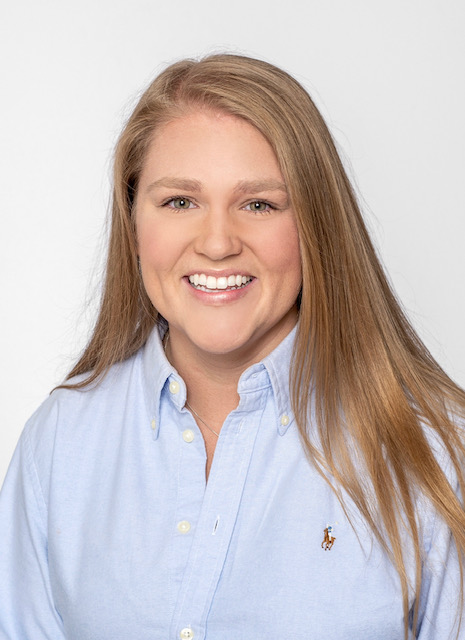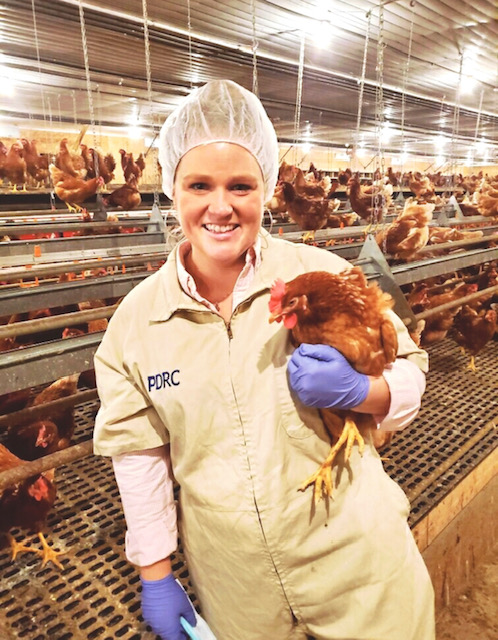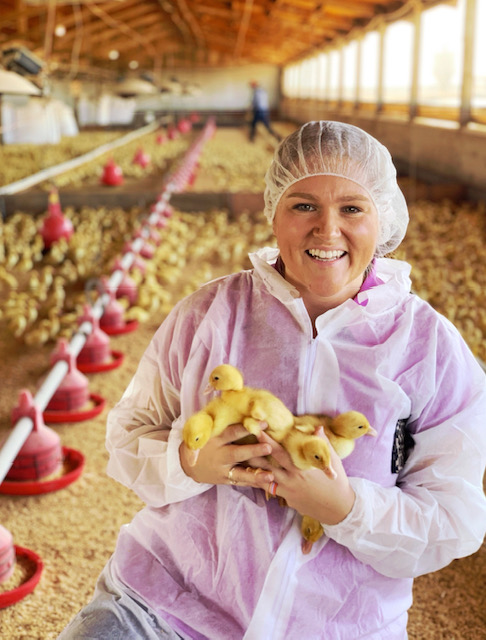Former poultry science student shares experiences and advice for current students
How the department’s technical option prepared her for vet school and a career as a poultry vet
The Texas A&M College of Agriculture and Life Sciences’ Department of Poultry Science prepares students with the scientific, technical and business knowledge needed to succeed in the ever-growing poultry industry.

Katie Burchfield, DVM, a 2015 graduate of the department from Longview, is one such student.
Burchfield, a traveling veterinarian for Pilgrim’s-JBS, works with a team of five veterinarians to provide preventative care, treatment and animal welfare oversight at six complexes in Texas, Louisiana, Arkansas and Florida.
Every day is different, she said, and the dynamics between complexes, bird sizes, broiler challenges versus breeder stock challenges and more make her job fun and always provides something new to work toward.
Her time as an undergraduate in poultry science prepared her for vet school and her future career. Burchfield was able to complete all the necessary prerequisite courses as a participant of the department’s technical option. This option prepares students for advanced study in biochemistry, nutrition, physiology, molecular genetics, reproduction, processing technology, microbiology or environmental science. Students graduating under this option are equipped to attend professional school or for eventual employment in research, teaching and public service.
“That is one great thing about poultry science; it is not the typical choice for veterinary school hopefuls, but it does meet all the requirements,” said Burchfield. “Even students who want to be a traditional vet can stand out in the application process with a poultry degree or classes.”
After obtaining her veterinary degree at the Texas A&M School of Veterinary Medicine and Biomedical Sciences, Burchfield attended the University of Georgia for their Master of Avian Medicine program. An intensive 18-month residency focused solely on poultry medicine.
Below, Burchfield reflects on her time at Texas A&M University, why she chose poultry science and how she gives back to the university by helping foster internship opportunities.
Why did you choose to attend Texas A&M?
Participating in FFA events in high school provided exposure to Texas A&M. I knew that I wanted to attend veterinary school and it just felt like a good fit for undergraduate opportunities as well. The sense of family was apparent even as a visitor to campus. I am so thankful that I choose A&M. And even though I spent some time in Georgia, don’t worry. You won’t catch me saying “go dawgs.” It’s still “Gig’Em Aggies” for me.

What made you choose poultry science?
That can somewhat be attributed to my high school ag teachers from Burleson, Brandon Williamson and James Willson. They encouraged me to try poultry judging, which gave me the opportunity to learn about the department and meet some professors. I’m thankful for their passion for agriculture that rubbed off on me.
Having pre-veterinary classes in the curriculum also helped. Looking back, I am thankful for the department’s networking opportunities, unmatched scholarship support, and the small feeling at a big school.
Why did you want to attend vet school?
I always loved formal sciences like biology and chemistry in school and could always be found in the pig or horse barn when I wasn’t at school. During undergraduate school, I learned about poultry veterinarians and the role they played in bird health. That solidified my goal to get my DVM and work in the poultry industry.
If you weren’t doing this, what would you be doing?
I always say that if I was not a veterinarian, I would still be working in the poultry industry. I fell in love with production agriculture when I was young and think the poultry industry is the best at embodying innovation, technology, animal welfare and production, while still having the sense of family and hard work that drew me to agriculture. I think I would be involved with pharmaceutical sales, marketing or development if I was not a veterinarian. I love formal sciences and also helping feed the world.
What opportunities does your unit have for current university students?
Our veterinary team hosts interns every summer. These are usually veterinary students in their first three years of school. They are given a project that benefits their knowledge and resume, while also providing research information to the veterinary team.
We also take veterinary students in their clinical rotation time for two- to four-week sessions. They work on smaller projects or spend time shadowing the veterinary team. In some cases, members of the team will take undergraduates along for day trips or weeklong shadowing opportunities in the field.
I also guest lecture at Texas A&M in POSC 381, Investigation of Professional Development in Poultry Science, to expose students to the many different career options available in the poultry industry.

What was your favorite poultry science class?
How could I not say Anatomy and Physiology, A&P, or Poultry Diseases? Even though these were introductory, I can’t help but think of these classes fondly. They set the basis for becoming a veterinarian. They sparked interest in learning more about how a chicken lives, breaths, eats, battles diseases and so much more. One of the best professors and my mentor, Dr. David Caldwell, taught the A&P course. His teaching methods also made it my favorite course.
Can you share a fond memory from your time in the department?
There are just so many. I didn’t realize until years after how unique the study abroad trip to Mexico was for poultry students. We were exposed to very different poultry management practices than are typically seen in the U.S. It was a great opportunity to learn about different poultry diseases, hatchery and live-production management, marketing to different cultures and so much more.
Social events like crawfish boils helped the department feel like a family; judging contests, field trips and helping with summer camps can all be grouped into a close second.
What advice would you give to current students interested in pursuing a career like yours?
Jump in with both feet. Become passionate about the process and do not dwell on the length of schooling. Take every opportunity to learn about the poultry industry and networking. So much of my job is people and chicken management. It’s rare to find a poultry vet who wishes they were a traditional vet.


